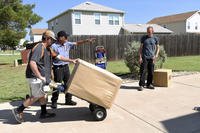The workday can be both heartbreaking and heartwarming for social workers who investigate and intervene in cases of child maltreatment. Such child-protection social workers face the wrenching realities of abuse and neglect firsthand, but they are also instrumental in preventing further harm and aiding families struggling with mental illness or substance abuse.
"This work is certainly not for the faint of heart," says Allison Blake, MSW, president of the New Jersey chapter of the National Association of Social Workers (NASW), who worked in child welfare for 20 years. "It's very difficult participating in child-abuse investigations, but what could be more rewarding than keeping kids safe and strengthening existing families?"
Safety First
Mariadonna Litwak, MSW, LSW, a family-services specialist for New Jersey's Division of Youth and Family Services, is a "first responder" who initiates child-abuse investigations when her agency receives reports of suspected abuse or neglect. "I often go into crisis situations that need immediate de-escalation," Litwak says.
Litwak meets with everyone in the family, starting with the alleged victim. "We're trying to find out what happened, why and how," she says. "Our primary responsibility is to ensure safety." She looks for signs of substance abuse, domestic violence, and mental or physical illness, all of which may factor into the alleged abuse. She also tries to determine whether weapons are in the house. When Litwak knows she'll be entering an extremely volatile environment, a police escort from the state's human-services agency accompanies her.
Litwak must gather information from parents who may be resistant or hostile to questioning. Gathering neutral family facts like birthdays is often a good place to start the conversation before asking directly about the alleged maltreatment. "You have to get the best information you can in a very short time frame," Litwak says.
If Litwak assesses that a child is safe, he is left in the home while the investigation continues. If the child appears to be in imminent danger, Litwak contacts a supervisor to determine the next step, which could be requesting the alleged perpetrator of the abuse leave the home or asking relatives to take the child or children in. Litwak's active involvement in a case lasts 45 to 60 days, after which a determination about the child's long-term living situation is made.
"You have to be very determined and committed to succeed in this type of work," she says. Child-protection social workers must understand family dynamics and have the skills to judge whether a child is on target developmentally, Litwak says. They must also be flexible. Litwak sometimes must initiate investigations at night and on weekends or make prescheduled visits to families outside of regular working hours.
Public Misconceptions
Since the media often lambaste them when a death or crisis occurs, child-protection social workers also need a thick skin. Although "social workers" are blamed for such tragedies, child-protection caseworkers without social work degrees are ill-prepared to interview families or perform appropriate interventions, Blake says.
Another public misconception is that child-welfare workers involved in tragic cases are uncaring or willfully negligent. "In reality, caseloads are too high, or the staff hasn't received the training necessary to do their jobs well," Blake says.
For social workers who want to further their knowledge and training, the NASW Credentialing Center offers voluntary specialty certifications for BSWs and MSWs.
Widespread Need
Sadly, demand is high for child-protection workers, who earn about $32,000 to start, says an NASW survey. Every day, an average of 2,400 children are abused, and three die as a result of abuse or neglect, according to the US Department of Health and Human Services. Nationwide, agencies dedicated to child-protective services receive more than 50,000 calls per week regarding suspected or known instances of child abuse; more than two-thirds are deemed appropriate for investigation.
Child protection is just one component of the child-welfare system, a continuum of services that includes family preservation, family foster care, group homes, residential facilities and adoption services.
Working within this system is often frustrating for even the most dedicated social worker. Litwak's commitment to children is what keeps her going. "It's a great feeling to make a difference in the life of a child, even for five minutes," she says.
This article originally appeared on Monster Career Advice.






















